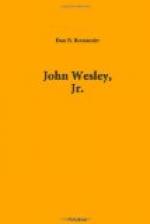It was through Joe Carbrook that he got his next jolt. Joe, now spending his vacations in ways that amazed people who had memories of his wild younger manner, was in and out of the Farwell store a good deal. Also he spent considerable time with Pastor Drury, though there is no record of what they talked about.
“J.W., old boy,” Joe asked one day, coming away from the pastor’s study, “have you ever by any chance observed Main Street?”
“Why, yes,” J.W. answered, “seeing that two or three or four times a day I walk six blocks of it back and forth to this store door, I suppose I have.”
“Oh, yes, that way,” Joe came back at him, “and you’ve seen me, a thousand times. But did you ever observe me? My ears, for instance,” and he put his hands over them. “Which one is the larger?”
Without in the least understanding what his friend was driving at, and stupidly wondering if he ever had noticed any difference in Joe’s ears, J.W. stared with inane bewilderment. “Is one really larger than the other?” he asked, helplessly.
Joe took his hands down, and laughed. “I knew it,” he said. “You’ve never observed my ears, and yet you think you have observed Main Street. As it happens, each of my ears takes the same-sized ear-muff. But you didn’t know it. Well, never mind ears; I’m thinking about Main Street. What do you know of Main Street?”
J.W. thought he could make up for the ear question. So he said, boldly, “Joe Carbrook, I can name every place from here to the livery barn north, and from here to the bridge south, on both sides of the street. Want me to prove it?”
“No, J.W., I don’t. I reckon you can. But I believe you’re still as blind as I’ve been about Main Street, just the same. I know Chicago pretty well and I doubt if there’s as big a percentage of graft and littleness and dollar-pinching and going to the devil generally on State Street or Wabash Avenue as there is an Main Street, Delafield.”
“You’re not trying to say that our business men are crooks, are you, Joe?” J.W. asked, with a touch of resentment. “You know I happen to be connected with a business house on Main Street myself.”
“Sure, I know it, and there’s Marshall Field’s on State Street, and Lyon & Healy’s on Wabash Avenue, and Hart, Schaffner & Marx over by the Chicago River; just the same as here. But I—well, of course, there’s a story back of it all. Mother heard a couple of weeks ago that one of our old Epworth League girls was having a hard time of it—she’s working at the Racket store, helping to support her folks. They’ve had sickness, and the girl doesn’t get big wages. So mother asked me to look her up. Mother can’t get about very easily, you know, and since I’m studying medicine she seems to think I’m the original Mr. Fix-It. I made a few discreet inquiries, discreet, that is, for me, and can you guess who that girl is? You can’t, I know. Well, she’s Alma Wetherell, and that’s the identical girl who gave me such a dressing down one day at the Cartwright Institute four years ago. Remember? Say, J.W., that day she told me so much of the deadly truth about myself that I hated her even more for knowing what to say than I did for saying it. But she had a big lot to do with waking me up, and I owe her something.”




